What is Leadership?
Leadership is the ability to inspire and guide individuals or a group towards a common goal or vision. It involves taking charge, making decisions, and motivating others to achieve success. Leadership styles play a crucial role in shaping the success of a business, as different approaches to management have distinct impacts. There are various leadership styles, each with its own set of advantages and disadvantages.
Among the most common leadership styles are autocratic, democratic, and laissez-faire. Autocratic leadership can be effective in situations requiring quick decisions, but it may result in limited employee engagement and creativity. On the other hand, democratic leadership fosters collaboration and creativity, although it might lead to slower decision-making processes. Laissez-faire leadership offers greater employee autonomy and creativity potential, but it also carries the risk of a lack of direction and accountability.
In total, there are 8 different leadership styles, each with its unique strengths and weaknesses. Determining the best leadership style for an organization depends on the company’s specific needs and circumstances. Leaders should have a deep understanding of the various leadership styles and how they can be harnessed to foster a productive and successful work environment.
Autocratic Leadership Style
Autocratic leadership is a leadership style where the leader has complete control and authority over decision-making and task delegation. Here are the pros and cons of autocratic leadership:
Pros:
- Quick decision-making: Autocratic leaders can make decisions swiftly without consulting others, which is beneficial in time-sensitive situations.
- Clear direction: This style provides clear instructions and expectations, ensuring that everyone knows what needs to be done.
- Efficient in emergencies: Autocratic leaders can take charge during crisis situations and provide immediate guidance.
Cons:
- Lack of employee involvement: Autocratic leaders rarely seek input from their team, leading to limited employee engagement and motivation.
- Reduced creativity: With little room for collaboration and input, this style may stifle innovation and creative problem-solving.
- Potential for resentment: Employees may feel demoralized or undervalued when their ideas and opinions are consistently disregarded.
It’s essential to note that while the autocratic leadership style can be effective in certain scenarios, it may not be suitable for fostering a collaborative and inclusive work environment.
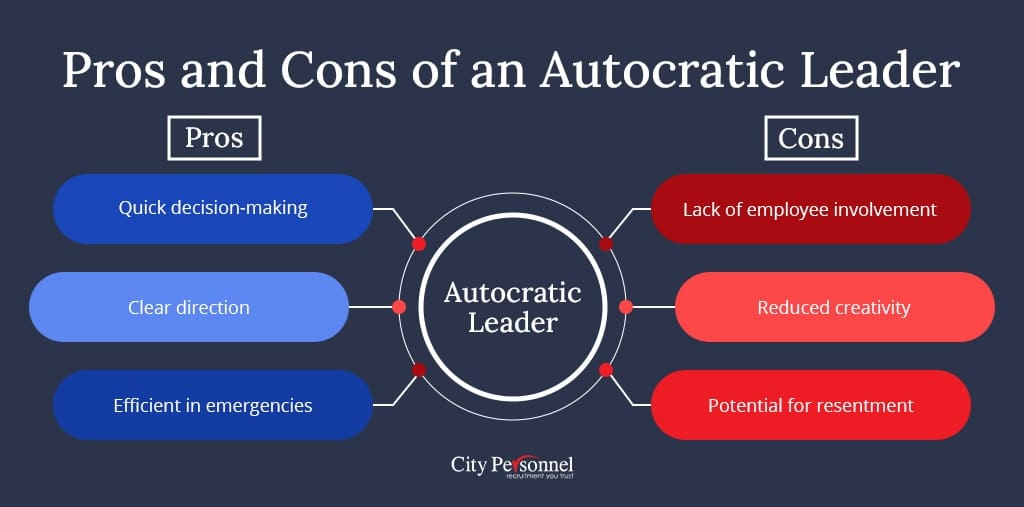
Bureaucratic Leadership Style
Bureaucratic leadership is a leadership style characterized by strict adherence to rules, policies, and procedures. Here are the pros and cons of bureaucratic leadership:
Pros:
- Clear structure: Bureaucratic leaders establish clear hierarchies, roles, and responsibilities, which can promote order and efficiency within an organization.
- Consistency: This style ensures consistency in decision-making and implementation, as actions are based on established protocols and guidelines.
- Stability: Bureaucratic leadership provides stability and predictability, which can be reassuring for employees and stakeholders.
Cons:
- Lack of flexibility: The rigid adherence to rules and procedures can hinder adaptability to change or unique situations, potentially slowing down decision-making.
- Limited innovation: Bureaucratic leaders may discourage creativity and risk-taking due to their emphasis on following established protocols.
- Impersonal relationships: The focus on rules and procedures may result in a lack of personalized attention and connection with employees.
It’s important to note that while bureaucratic leadership can provide stability and structure, it may not be suitable for organizations that require agility, innovation, and a more flexible approach.
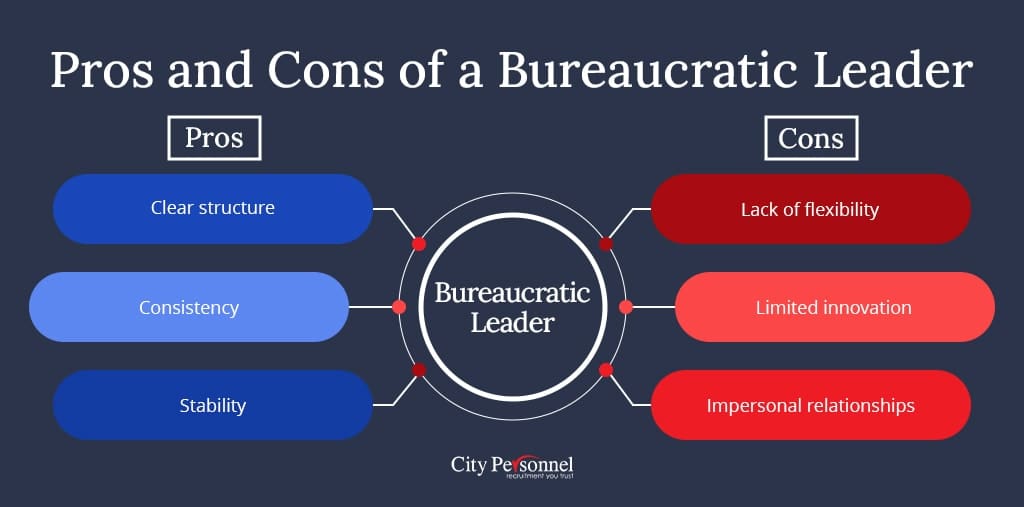
Transactional Leadership Style
Transactional leadership is a leadership style that focuses on the exchange of rewards and punishments to motivate and manage employees. Here are the pros and cons of transactional leadership:
Pros:
- Clear expectations: Transactional leaders establish clear performance expectations, goals, and timelines, ensuring that employees understand what is expected of them.
- Reward-based motivation: This style offers rewards, such as bonuses or recognition, for meeting or exceeding performance targets, which can incentivize employees to perform well.
- Efficient task management: Transactional leaders emphasize accountability and efficient task completion, which can contribute to productivity and goal attainment.
Cons:
- Limited employee development: Transactional leadership may not prioritize long-term employee growth and development, as the focus is primarily on meeting immediate targets.
- Lack of creativity: The emphasis on adhering to established processes and procedures may stifle innovation and creative problem-solving.
- Potential for dependence: Employees may become overly reliant on external rewards, potentially decreasing intrinsic motivation and self-initiative.
It’s important to note that while transactional leadership can be effective in achieving short-term goals and maintaining performance standards, it may not foster a supportive and innovative work environment in the long run.
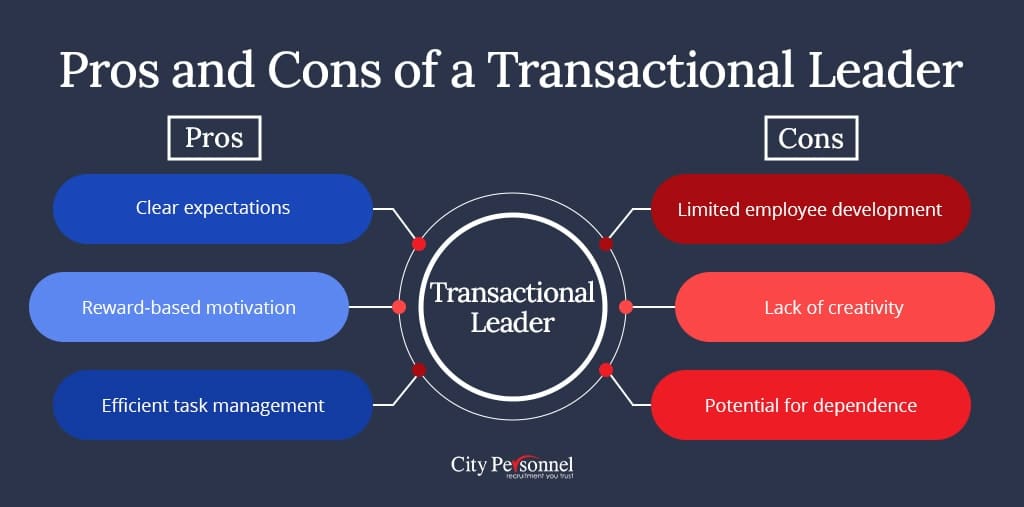
Democratic Leadership Style
Democratic leadership is a leadership style that emphasizes collaboration, participation, and shared decision-making. Here are the pros and cons of democratic leadership:
Pros:
- Inclusive decision-making: Democratic leaders involve team members in the decision-making process, giving them a sense of ownership and commitment.
- Enhanced creativity and innovation: By encouraging open communication and diverse perspectives, democratic leadership fosters creativity and innovative thinking within the team.
- Increased employee morale and motivation: When employees feel valued and included in decision-making, it can boost their morale and motivation to contribute actively.
Cons:
- Time-consuming decision-making: The participatory nature of democratic leadership can potentially slow down the decision-making process, especially in complex or time-sensitive situations.
- Difficulty in consensus-building: In certain cases, reaching a consensus among team members may be challenging, leading to delays or compromises that may not satisfy everyone.
- Potential for conflict: Increased involvement and differing opinions can lead to conflicts within the team if not managed effectively.
Democratic leadership is a leadership style that emphasizes collaboration, participation, and shared decision-making. Here are the pros and cons of democratic leadership in bullet format:
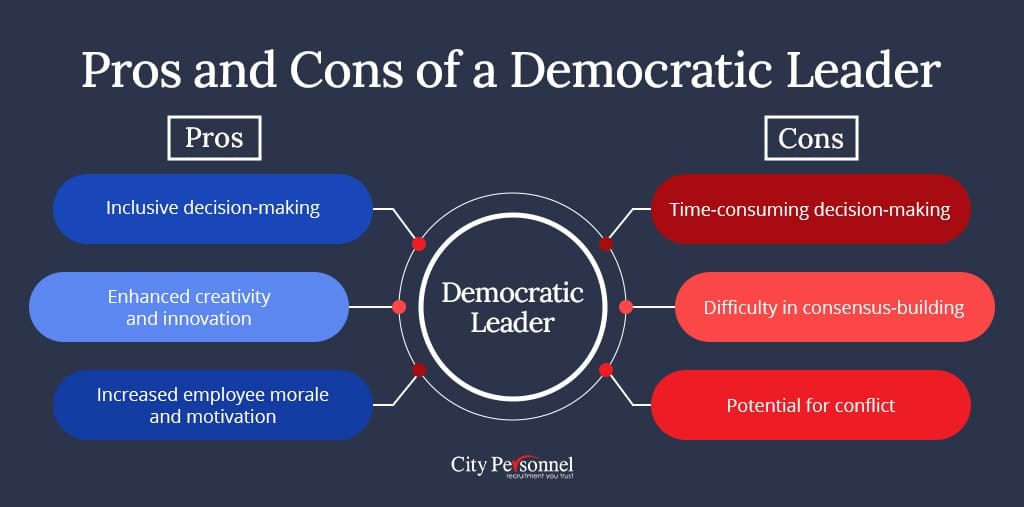
Laissez-Faire Leadership Style
Laissez-faire leadership is a leadership style characterized by minimal interference or direction from the leader, allowing employees to have a high degree of autonomy and decision-making authority. Here are the pros and cons of laissez-faire leadership:
Pros:
- Empowers employees: Laissez-faire leadership gives employees the freedom to make decisions and take ownership of their work, fostering a sense of empowerment and autonomy.
- Encourages creativity and innovation: With minimal interference, employees have the space to explore new ideas, think creatively, and innovate within their roles.
- Promotes self-motivation: Laissez-faire leaders trust their employees’ abilities, which can enhance self-motivation and intrinsic drive.
Cons:
- Lack of structure and guidance: The absence of clear direction and oversight may result in confusion, lack of focus, and decreased productivity.
- Potential for inadequate communication: Laissez-faire leaders may not provide sufficient communication or support, leading to misunderstandings and a lack of coordination among team members.
- Accountability challenges: Without regular monitoring, some employees may not take full responsibility for their work, potentially resulting in missed deadlines or subpar performance.
It’s important to note that while laissez-faire leadership can be effective in certain contexts, it requires a highly skilled and self-motivated team to thrive.
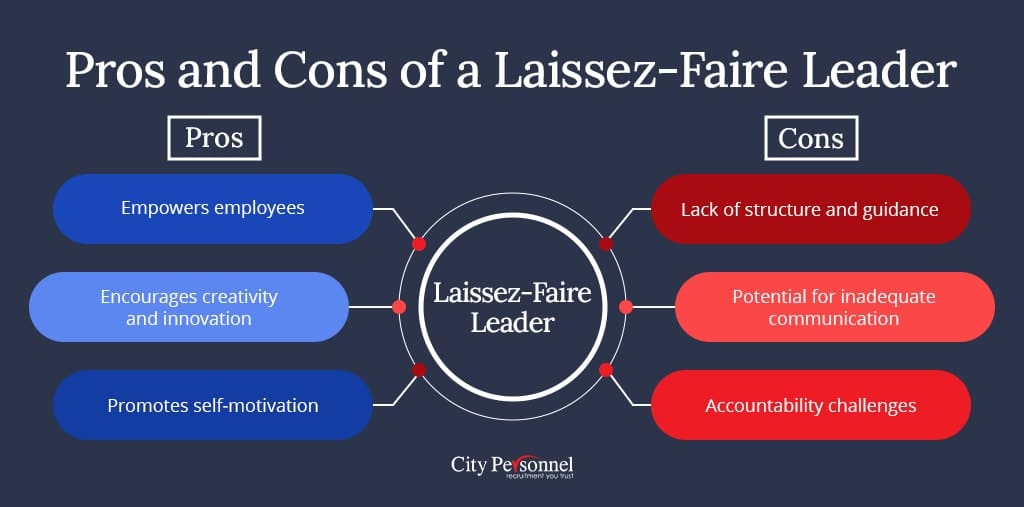
Charismatic Leadership Style
Charismatic leadership is a leadership style characterized by the leader’s ability to inspire and influence others through their personal charm, vision, and persuasive communication. Here are the pros and cons of charismatic leadership:
Pros:
- Inspires and motivates: Charismatic leaders possess a natural ability to inspire and motivate others, often attracting followers who are loyal and committed to achieving shared goals.
- Visionary leadership: They are known for their compelling vision and the ability to articulate it effectively, which can rally individuals and teams around a common purpose.
- Effective communication: Charismatic leaders excel at communicating their ideas and influencing others through their charisma, creating enthusiasm and buy-in.
Cons:
- Dependency on the leader: Charismatic leadership can create a strong dependency on the leader, making it challenging for the organization to sustain momentum and performance in their absence.
- Potential for unethical behavior: Charismatic leaders’ persuasive abilities can be used to manipulate or sway others towards unethical or self-serving actions.
- Lack of focus on details: Due to their visionary nature, charismatic leaders may overlook or pay less attention to the operational and day-to-day aspects of running an organization.
It’s important to note that while charismatic leadership can be highly effective in inspiring and motivating teams, it should be complemented by strong organizational structures and ethical practices to ensure long-term success.

Transformational Leadership Style
Transformational leadership is a leadership style that focuses on inspiring and motivating followers to achieve their full potential and exceed their own expectations. Here are the pros and cons of transformational leadership:
Pros:
- Inspirational and visionary: Transformational leaders have a clear vision and are adept at inspiring and motivating their followers to work towards a common goal.
- Individualized attention: They provide personalized support and mentorship to their followers, helping them develop their skills and reach their full potential.
- Promotes innovation and creativity: Transformational leaders encourage creativity and innovation by fostering an environment where new ideas are valued and supported.
Cons:
- Dependency on the leader: The success of a transformational leadership style heavily relies on the presence and influence of the leader. When the leader is absent or less effective, it can affect the team’s motivation and performance.
- High expectations and pressure: Transformational leaders set high standards for their followers, which can create stress and pressure to consistently meet or exceed those expectations.
- Time and energy-intensive: The level of involvement and personalized attention required in transformational leadership can be time-consuming and demanding for the leader.
It’s important to note that while transformational leadership can have significant positive effects on individuals and organizations, it requires a strong and committed leader who can effectively communicate the vision and inspire others to embrace change.
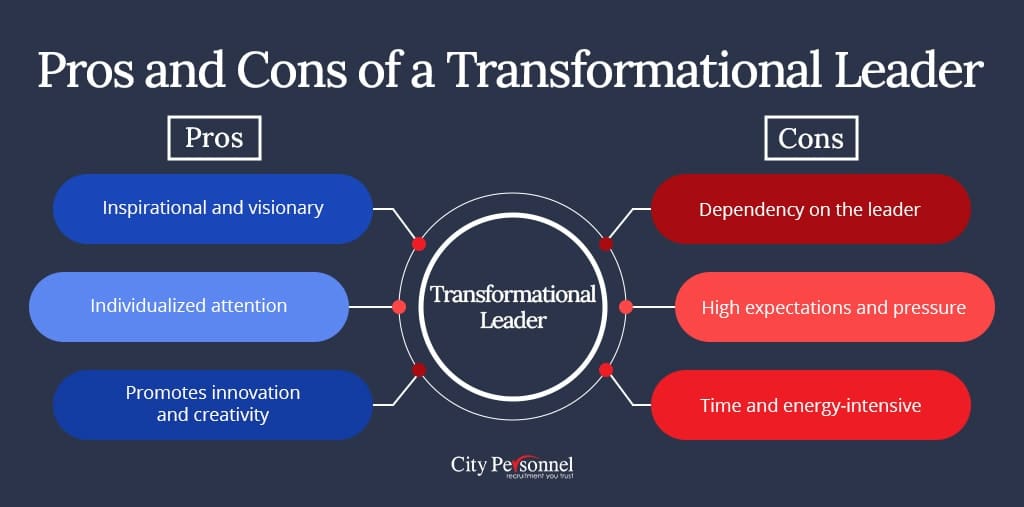
Servant Leadership Style
Servant leadership is a leadership style that emphasizes serving and prioritizing the needs of others, such as employees, team members, and the community. Here are the pros and cons of servant leadership:
Pros:
- Focus on empathy and listening: Servant leaders actively listen to the needs and concerns of their followers, fostering a supportive and empathetic work environment.
- Encourages collaboration and teamwork: Servant leaders promote collaboration, teamwork, and the development of strong relationships among team members.
- Builds trust and loyalty: By prioritizing the well-being and growth of their followers, servant leaders build trust and loyalty, creating a positive organizational culture.
Cons:
- Potential for indecisiveness: Servant leaders may prioritize consensus-building and the needs of others to a degree that it hampers decision-making and timely action.
- Requires time and effort: The servant leadership approach demands significant time and effort to understand and address the needs of individual team members.
- Balance between serving and leading: Striking a balance between serving the needs of others and providing guidance and direction can be challenging for some leaders.
It’s important to note that while servant leadership can create a positive and empowering work environment, it requires leaders to have a genuine desire to serve others and a deep commitment to their growth and well-being.

Which Leadership Styles are the Best?
When it comes to leadership styles, there is no one-size-fits-all approach to leadership. Different leadership styles can be used in different contexts and situations, depending on the needs of the organization and the team. Autocratic, democratic, laissez-faire, transformational, transactional, and servant leadership styles all have their own advantages and disadvantages. Ultimately, the best leadership style is the one that works best for the organization and its team members. Leaders should be flexible and willing to adjust their approach to fit the needs of their team.
By understanding the different leadership styles and their implications, successful leaders can make informed decisions and create an environment that encourages collaboration, innovation, and growth.





